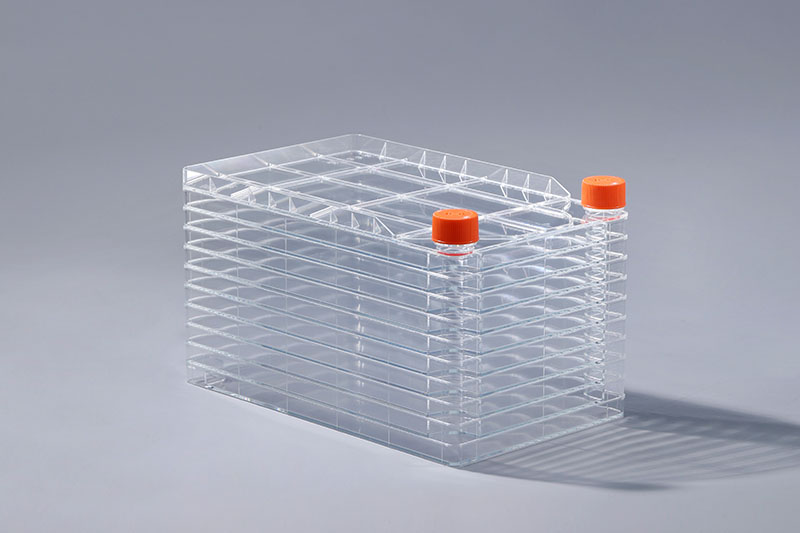Med den djupgående utvecklingen av området för biovetenskap används cellodlingsteknologi i stor utsträckning inom många områden som bioläkemedel, industriell vaccinproduktion och monoklonala antikroppar. Beroende på de olika sätten för celltillväxt delas den in i två kategorier: vidhäftande celler och suspensionsceller. Så vilka celler kan odlas med cell factorys?
Cellfabriken är en flerskiktsstruktur av cellodlingsförbrukningsmaterial. Vanliga specifikationer inkluderar 1 lager, 2 lager, 5 lager, 10 lager, 40 lager, etc. Det används främst för odling av vidhäftande celler. Tillväxten av vidhäftande celler måste ha en stödyta som kan fästas, och celler kan växa och föröka sig på denna yta genom att förlita sig på de vidhäftningsfaktorer som utsöndras av dem själva eller tillhandahålls i odlingsmediet. Efter att cellerna fäster täcker de vanligtvis odlingsytan inom några dagar och bildar ett tätt cellmonoskikt, såsom Vero-celler, HEK 293-celler, CAR-T-celler, MRC5, CEF-celler, grisalveolära makrofager, myelomceller, DF - 1-celler, ST-celler, PK15-celler, Marc145-celler, etc. fästes alla till cellfabriken för odling.
Dessutom kan denna förbrukningsvara också användas för stationär odling av suspensionsceller. Suspensionsceller avser celler som växer oberoende av underlagets yta och växer i suspension i odlingsmediet, såsom lymfocyter. Cellfabriker tillverkas vanligtvis av polystyrenråmaterial och ytan är hydrofob. Om den används för adherent cellkultur måste ytan behandlas med TC för att öka dess hydrofilicitet, vilket är lämpligt för cellvidhäftande tillväxt.
Cell factories are generally produced from polystyrene raw materials, and the surface is hydrophobic. If it is used for adherent cell culture, the surface needs to be treated with TC to increase its hydrophilicity, which is suitable for cell adherent growth.
The FAI climbed 5.9 percent year-on-year in the first 11 months of 2018, quickening from the 5.7-percent growth in Jan-Oct, the National Bureau of Statistics (NBS) said Friday in an online statement.
The key indicator of investment, dubbed a major growth driver, hit the bottom in August and has since started to rebound steadily.
In the face of emerging economic challenges home and abroad, China has stepped up efforts to stabilize investment, in particular rolling out measures to motivate private investors and channel funds into infrastructure.
Friday's data showed private investment, accounting for more than 60 percent of the total FAI, expanded by a brisk 8.7 percent.
NBS spokesperson Mao Shengyong said funds into weak economic links registered rapid increases as investment in environmental protection and agriculture jumped 42 percent and 12.5 percent respectively, much faster than the average.
In breakdown, investment in high-tech and equipment manufacturing remained vigorous with 16.1-percent and 11.6-percent increases respectively in the first 11 months. Infrastructure investment gained 3.7 percent, staying flat. Investment in property development rose 9.7 percent, also unchanged.
 English
English



















































